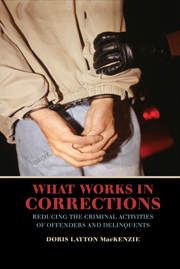Book contents
- Frontmatter
- Contents
- Acknowledgments
- PART ONE STRATEGIES FOR REDUCING CRIME
- 1 Strategies for Reducing Recidivism
- 2 Evidence-Based Corrections
- 3 Incapacitation
- 4 Perspectives on Rehabilitation
- PART TWO THE EFFECTIVENESS OF REHABILITATION PROGRAMS
- PART THREE TARGETING SPECIFIC TYPES OF OFFENDERS
- PART FOUR MANAGEMENT AND TREATMENT OF SUBSTANCE ABUSERS
- PART FIVE CONTROL, DISCIPLINE, AND PUNISHMENT
- PART SIX CONCLUSIONS
- References
- Index
- CAMBRIDGE STUDIES IN CRIMINOLOGY
4 - Perspectives on Rehabilitation
Published online by Cambridge University Press: 27 July 2009
- Frontmatter
- Contents
- Acknowledgments
- PART ONE STRATEGIES FOR REDUCING CRIME
- 1 Strategies for Reducing Recidivism
- 2 Evidence-Based Corrections
- 3 Incapacitation
- 4 Perspectives on Rehabilitation
- PART TWO THE EFFECTIVENESS OF REHABILITATION PROGRAMS
- PART THREE TARGETING SPECIFIC TYPES OF OFFENDERS
- PART FOUR MANAGEMENT AND TREATMENT OF SUBSTANCE ABUSERS
- PART FIVE CONTROL, DISCIPLINE, AND PUNISHMENT
- PART SIX CONCLUSIONS
- References
- Index
- CAMBRIDGE STUDIES IN CRIMINOLOGY
Summary
INTRODUCTION
For years after Martinson and his colleagues published their treatise on treatment in corrections, a common mantra regarding rehabilitation was “nothing works” (Martinson, 1979; Lipton, Martinson, & Wilkes, 1975); obviously, this is not true. Research demonstrates that some programs are effective (as discussed in this book). Furthermore, researchers have identified some principles that appear to be important for effective programs. In this chapter, I review some of the issues of concern to those interested in rehabilitation.
ACADEMIC DISCIPLINES AND TERMINOLOGY
Before discussing the principles of rehabilitation and the evidence supporting these principles, I want to clarify differences in the use of several terms. The meanings of the terms rehabilitation, treatment, and research differ depending upon the academic discipline of the person using the term. In the following sections, I discuss these differences.
Human Service Delivery
Criminologists use the terms rehabilitation and treatment differently depending on their academic discipline. Most psychologists working in the field of criminology define rehabilitation and treatment as some type of human service delivery. Others use the terms more generically. The latter group refers to probation and parole as treatments or rehabilitation. In meta-analyses or assessments of program effectiveness, researchers use rehabilitation to refer to a wide range of management strategies. They would include probation or intensive supervision with increased control as treatment even if these programs did not include any human service delivery.
- Type
- Chapter
- Information
- What Works in CorrectionsReducing the Criminal Activities of Offenders and Deliquents, pp. 53 - 66Publisher: Cambridge University PressPrint publication year: 2006



